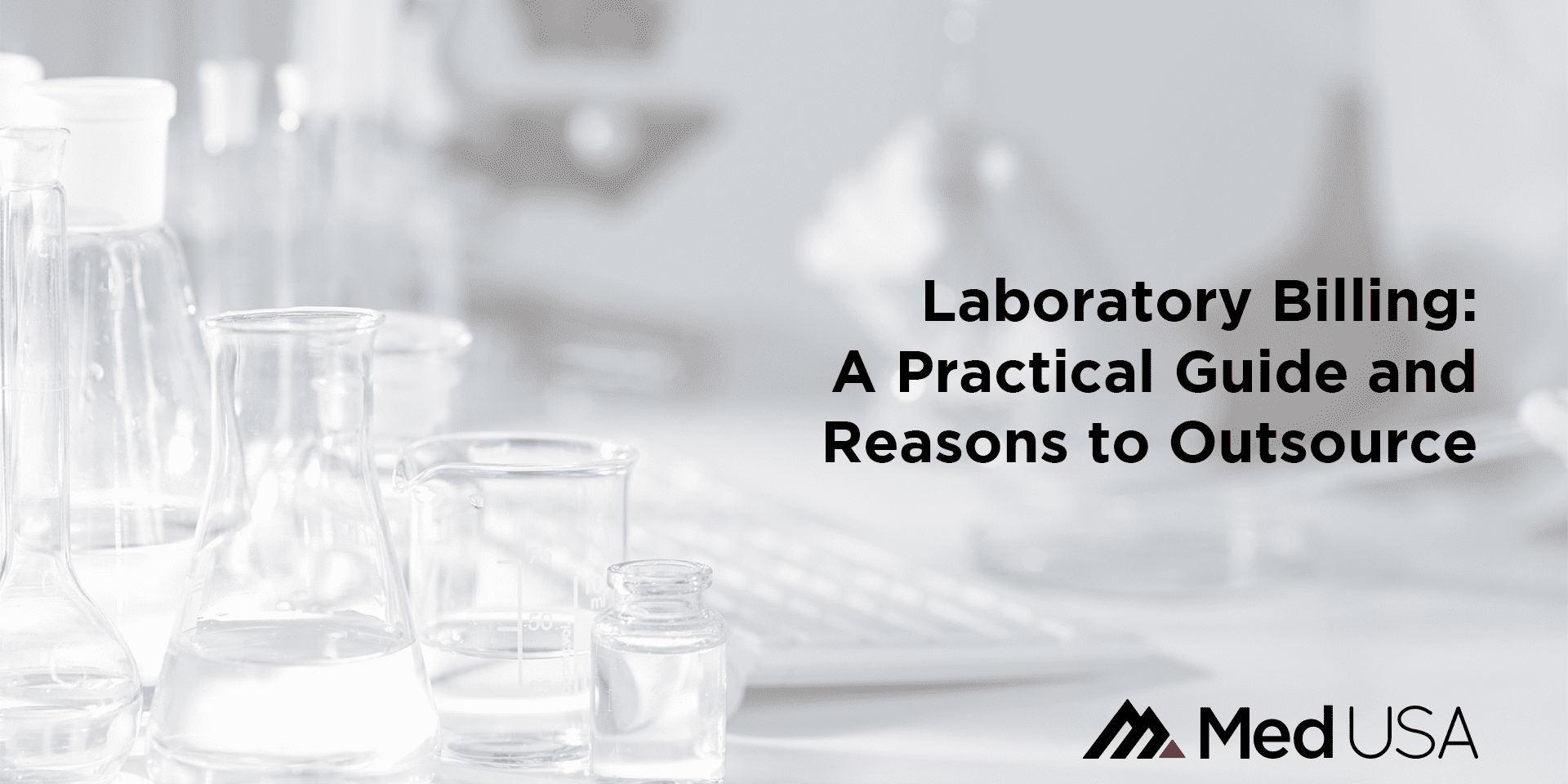
Laboratory Billing: A Practical Guide and Reasons to Outsource
Laboratories are a unique part of the medical establishment, appearing in a number of sizes and iterations. Most laboratories are located in or near hospital facilities, and provide support to physicians as they diagnose and prescribe treatment to their patients. While a hospital’s lab only accounts for 3 to 5% of the total revenue of a hospital, its findings make up 70 to 80% of a patient’s electronic health record (EHR) and can constitute the most critical component of medical treatment decisions. In fact, the CDC estimates that 70% of medical decisions depend on lab test results. For this reason, careful attention to the revenue produced by labs – as well as the working cash flow available to furthering technology, staffing, and providing other resources – means careful attention to improving patient outcomes.
While revenue is a critical point of focus for clinical laboratories, the primary workers who make up the majority of lab employees and directly influence it – the lab technicians – are most often not involved in the billing and revenue process. In fact, most labs house their billing facilities separately from the other portions of the lab. This separation allows lab technicians to focus on the laboratory information system (LIS), procedural equipment, and – most importantly – an ongoing mission to provide precise, accurate results and continued engagement with physicians and patients alike.
As such, laboratory medical billing requires a program built around the unique services provided by a medical lab versus services offered through a physician’s office or hospital visit. All lab tests are billed via a set of current procedural terminology (CPT) codes, and all the considerations named above require attention for what is a relatively complex billing cycle.
A Guide to Medical Laboratory Billing
Generally speaking, the medical laboratory billing cycle is the process of ongoing interactions between a physician ordering a lab test, the lab providing the services, and the insurance company or other payer who provides compensation for the time, labor, and materials used. This billing cycle can take anywhere from several days to months to complete, and it usually requires multiple interactions between the parties involved before its resolution. As mentioned, in most cases, laboratories have a separate coding and billing department designed to navigate the billing cycle.
How the Lab Billing Cycle Starts
The billing cycle begins with an order from a physician or other entity via a code for the specific lab test requested. After analysis of the specimen or sample is performed, labs are assigned a diagnosis or procedural code according to one of two separate coding indices used by the medical and insurance industry. These codes provide the insurance company or other payer the necessary information to determine whether to pay the claim.
Laboratory Billing Codes
Laboratory billing utilizes two primary sets of codes set forth for such purposes. The first is known as the International Classification of Diseases, or ICD. The ICD is maintained by the World Health Organization (WHO), and is accepted as the international diagnostic and epidemiological standard. It provides a framework of diagnostic codes that classify diseases, symptoms, injuries, and other complaints.
The second code set, known formally as the Current Procedural Technology Code Set and informally as the CPT, is provided by the American Medical Association and identifies services rendered rather than a diagnosis. The CPT code set delineates all the various medical, surgical, and diagnostic services performed by US practitioners. It is designed to provide a set of uniform classifications for use by medical providers, coders, insurance companies, and other payers.
Completion of the Billing Cycle
Once the correct codes are determined, the lab collections and revenue cycle management phase begins. In most cases, the lab bills the insurance company or other payer directly or via a clearinghouse, using an ANSI 837 claim file submitted electronically on an electronic data interchange (EDI). Once received, the payer utilizes medical claims adjusters or even advice from medical practitioners to evaluate medical necessity, patient eligibility, and provider credentials.
Finally, if a claim is approved, the payer reimburses the lab at a pre-negotiated rate for a percentage of the billed services. Denied or failed claims are sent back to the lab as an explanation of benefits (EOB). The lab provider must then make corrections and resubmit the claim. In many cases, this process occurs multiple times until the payer makes the agreed payment or the lab provider accepts a partial payment.
Use Laboratory Billing Information to Grow Your Lab
While your laboratory billing information provides you with all the information necessary to identify areas for future growth, you can’t grow your lab without a knowledge of basic lab economics. On the simplest level of analytics, you should track your overall patient volume to determine daily and monthly patient activity at all locations. In addition, you’ll want to know the gross charges and CPT codes associated with each patient interaction.
On a broader level, you can then calculate the expected gross billing per month and compare it to your actual patient activity. This key performance indicator (KPI) will help you discern whether your average charge level is consistent with your expectations; more specifically, whether your billing cycle is keeping up with your workflow. The revenue reports generated – representative of the cash your lab receives for its work – provide the clearest picture of how efficiently your lab billing department is operating.
However, your knowledge needs to incorporate much more than just gross revenue. Instead, you should focus on the percentage of your cash collections to each related patient interaction, perhaps most accurately reported as the accrual rate for each payer. Then, compare these accrual rates and your relationships with each payer, with the cost of individual CPT-coded procedures. Together with your other costs, including overhead and accession, you can use analytics to determine the profitability of each procedure, payer relationship, and client contract.; You can use similar projections to gauge the profitability of opportunities moving forward.
Unfortunately, dysfunctional laboratory billing procedures can lead to the opposite effect within your lab. If improper coding or billing procedures are used, accounts receivable time can aggregate as claim denials increase. In general, if your AR is sitting at 40-50 days, your billing department is functioning on average, but if AR times are consistently 60 days and over, you’re risking a cash flow shortage. A shortage of cash flow to your lab can hamper your efforts to continue providing services or purchase new equipment.
Reasons to Outsource Laboratory Billing
To accurately glean the above-mentioned information so crucial to the representation of your laboratory’s daily, weekly, and monthly activities, many labs implement a laboratory information system (LIS) to provide an electronic health or laboratory record. While a LIS can improve your internal workflow, and improve the communications between your lab, medical providers, patients, and payers as well as help to streamline your billing processes, simply installing a software program isn’t enough. You’ll need to dedicate time to properly analyze the data captured by your billing system and develop the skills necessary to glean information from it, primarily to identify strengths, areas of need, and opportunities for growth.
For many labs, outsourcing laboratory billing can be a way to achieve the necessary deep revenue analysis while preserving personnel resources for other essential activities. A much more thorough approach to laboratory billing rather than simply adding a software system, partnering with a laboratory billing firm can have numerous benefits.
- Reduced operating costs and improved cash flow. Maintaining a laboratory billing department of your own involves the associated software fees, and initial and ongoing training costs of keeping salaried, skilled employees on your payroll. As the US healthcare system’s overhead costs balloon to approximately $750 billion USD, cutting your overhead costs by outsourcing your billing is a great way to reduce expenditures and promote healthy cash flow.
- Elimination of billing and coding errors. According to Pat Palmer, CEO and founder of Medical Billing Advocates of America, nearly 80% of medical claims contain some type of billing error. Outsourcing your billing to a company that uses and maintains state of the art billing software can reduce your chances of submitting claims containing coding or billing errors that can delay payments and increase your billed hours. Most importantly, accurate billing and coding results in improved data for your analysis reports.
- Automatic verification. Improper verification and eligibility is the number one cause of claims denials. If you currently utilize an in-house billing staff to verify coverage, medical necessity, or other claims information, outsourcing your verification services can improve accuracy and reduce the number of hours utilized on procedures much more easily managed by an automated system. Better yet, you won’t need to invest time and effort into keeping staff up to date on coding changes.
- Quicker processing and payment. Automating the above tasks results in the much quicker completion of your end of billing cycle. Instead of the months often required for processing a typical paper claim, using an automated software system to file a flawless claim prepared by an expert coder can result in payment in just a few days.
Laboratory Billing Services Are Likely a Positive Step Forward For Your Lab
Regardless of which particular ERM software or services your lab requires, managed laboratory billing services are a solution for your staffing and analysis issues. Outsourcing your laboratory billing can result in quicker resolution of the billing process and supply better data for analysis. In turn, better data can help you identify loss leaders, improve your efficiency, plan strategically for growth opportunities, and drastically improve your cash flow.
Hire an Experienced Laboratory Billing Company
Your lab deserves every effort possible to improve efficiencies, increase revenue, and seize opportunities for growth. However, many lab managers simply don’t have the time, staff, or resources necessary to dedicate an adequate focus to the nuances of laboratory billing. Hiring a lab billing partner to help you manage your lab revenue cycle is a real opportunity for improved lab performance and revenue growth.


